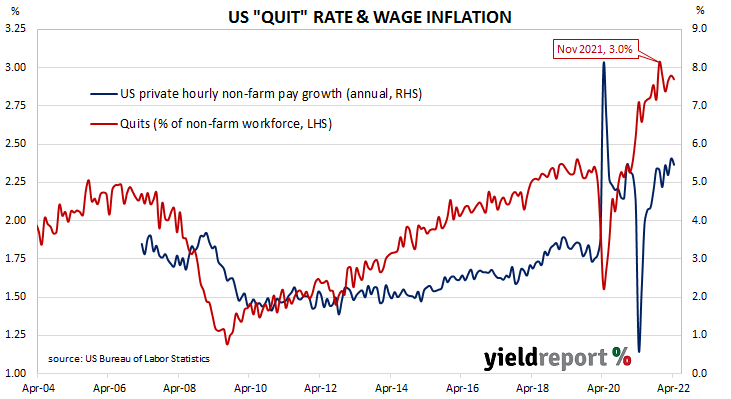Summary: US quit rate unchanged in April; quits, openings, separations all down; almost two job openings for every unemployed person, “no cooling yet”.
The number of US employees who quit their jobs as a percentage of total employment increased slowly but steadily after the GFC. It peaked in March 2019 and then tracked sideways until virus containment measures were introduced in March 2020. The quit rate then plummeted as alternative employment opportunities rapidly dried up. Following the easing of US pandemic restrictions, it proceeded to recover back to its pre-pandemic rate in the third quarter of 2020 before trending higher through 2021.
Figures released as part of the most recent Job Openings and Labor Turnover Survey (JOLTS) report show the quit rate remained unchanged in April. 2.9% of the non-farm workforce left their jobs voluntarily, unchanged from March’s figure of 2.9% after it was revised down from 3.0%. Even though there were 25,000 fewer quits during the month and an additional 428,000 people employed, the quit rate remained unchanged after rounding.
US Treasury yields increased on the day, although not at the ultra-long end. By the close of business, the 2-year Treasury bond yield had jumped 9bps to 2.65% and the 10-year yield had gained 6bps to 2.91%. The 30-year yield finished unchanged at 3.06%.
In terms of US Fed policy, expectations of higher federal funds rates over the next 12 months firmed up. At the close of business, June contracts implied an effective federal funds rate of 1.08%, 25bps higher than the current spot rate while July contracts implied a rate of 1.405%. May 2023 futures contracts implied 3.165%, 234bps above the spot rate.
The fall in total quits was led by 57,000 fewer resignations in the “Accommodation and food services” sector while the “Professional and business services” sector experienced the single largest rise, increasing by 46,000. Overall, the total number of quits for the month fell from March’s revised figure of 4.449 million to 4.424 million.
Total vacancies at the end of April decreased by 455,000, or 3.8%, from March’s revised figure of 11.855 million to 11.400 million. The fall was driven by a 266,000 drop in the “Health care and social assistance” sector, a 162,000 decrease in the “Retail trade” sector and a 149,000 decline in the Professional and business services” sector. The “Transportation, warehousing, and utilities” sector experienced the single largest increase, rising by 97,000. Overall, 11 out of 18 sectors experienced fewer job openings than in the previous month.
“There are almost two job openings for every unemployed person in the US,” said NAB currency strategist Rodrigo Catril. “Fed Chair Powell specifically referenced the job openings to unemployed ratio as one indicator he is watching for some early evidence of a potentially cooling in the labour market, and clearly there is no cooling yet.”
Total separations decreased by 215,000, or 3.4%, from March’s revised figure of 6.248 million to 6.033 million. The fall was led by the “Professional and business services” sector where there were 82,000 fewer separations than in March. Separations decreased in 12 out of 18 sectors.
The “quit” rate time series produced by the JOLTS report is a leading indicator of US hourly pay. As wages account for around 55% of a product’s or service’s price in the US, wage inflation and overall inflation rates tend to be closely related. Former Federal Reserve chief and current Treasury Secretary Janet Yellen was known to pay close attention to it.


